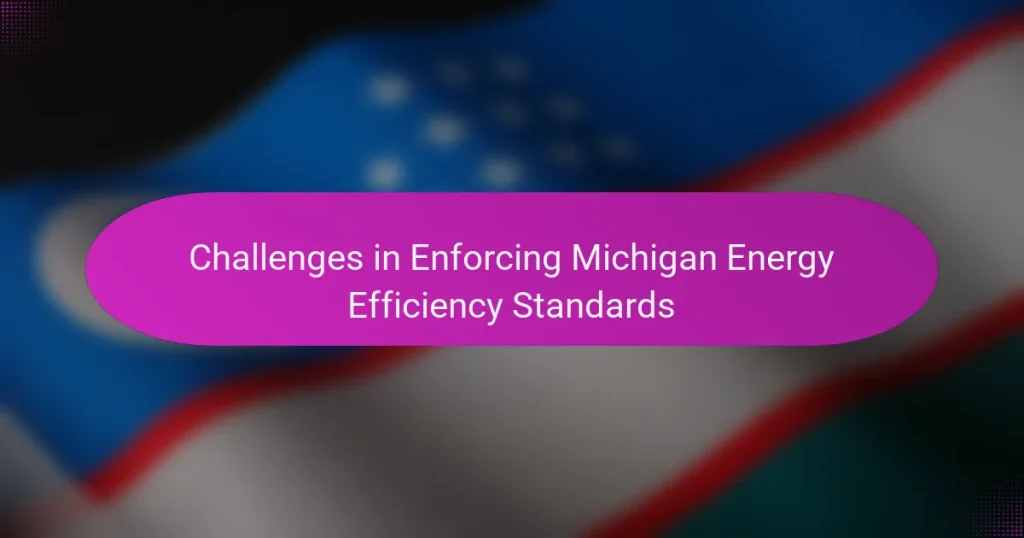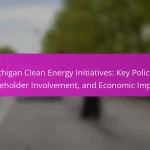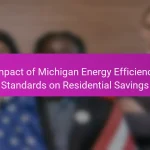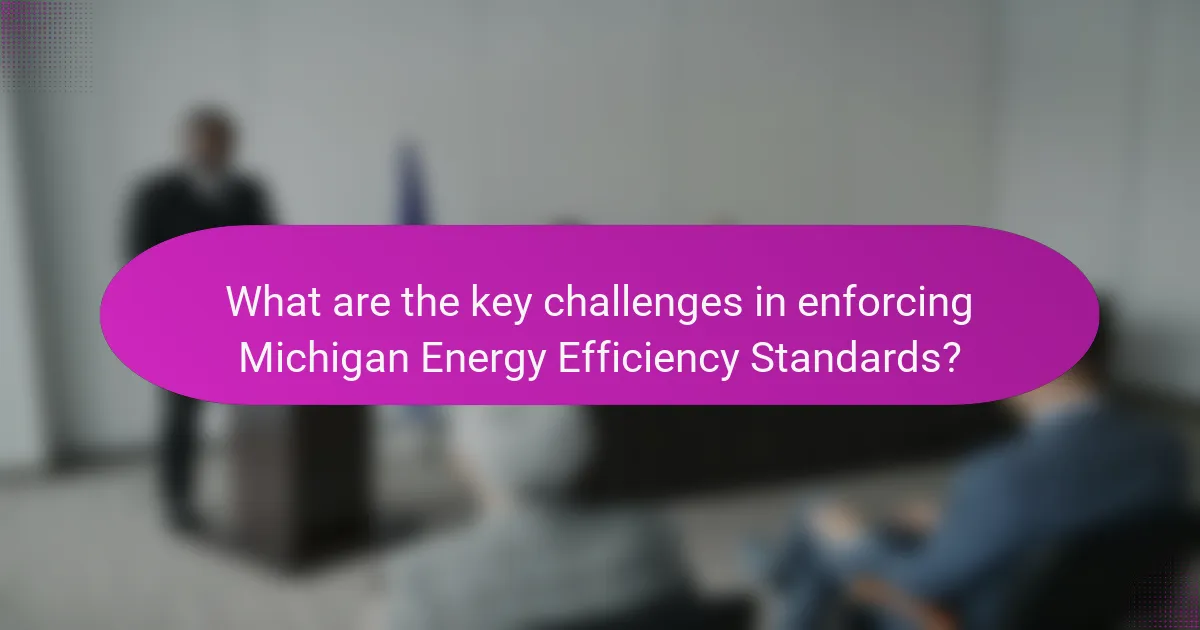
What are the key challenges in enforcing Michigan Energy Efficiency Standards?
Key challenges in enforcing Michigan Energy Efficiency Standards include limited funding, lack of awareness, and regulatory complexities. Limited funding restricts the ability to implement and monitor energy efficiency programs effectively. Many stakeholders, including consumers and businesses, may not fully understand the standards or their benefits. This lack of awareness can lead to lower participation rates in energy-saving initiatives. Regulatory complexities arise from overlapping jurisdictions and inconsistent policies among different agencies. These factors collectively hinder the effectiveness of energy efficiency standards in Michigan.
How do regulatory frameworks impact the enforcement of these standards?
Regulatory frameworks significantly influence the enforcement of Michigan energy efficiency standards. They establish the legal structure within which these standards operate. Compliance requirements are defined by these frameworks, guiding entities on acceptable practices. Regulatory bodies are empowered to monitor adherence to these standards. They can impose penalties for non-compliance, thus incentivizing adherence. For instance, the Michigan Public Service Commission oversees energy efficiency programs. Their authority ensures that utilities meet established energy-saving targets. Effective regulatory frameworks can enhance accountability and drive improvements in energy efficiency practices.
What specific regulations govern energy efficiency in Michigan?
The specific regulations governing energy efficiency in Michigan include the Clean, Renewable, and Efficient Energy Act (Public Act 295 of 2008). This act mandates energy optimization programs for utilities. It requires utilities to achieve energy savings targets of 1% annually. The Michigan Public Service Commission oversees compliance with these regulations. Additionally, the Energy Efficiency Standards (Public Act 342 of 2016) further establishes energy savings requirements for electric and gas utilities. These regulations aim to reduce energy consumption and promote sustainable practices.
How do changes in legislation affect enforcement efforts?
Changes in legislation can significantly impact enforcement efforts. New laws may introduce stricter standards or alter existing regulations. This can lead to increased compliance requirements for entities involved in energy efficiency. Consequently, enforcement agencies may need to adapt their strategies and resources to ensure compliance. For instance, changes could necessitate more frequent inspections or updated training for enforcement personnel. Historical data shows that legislative changes often correlate with shifts in compliance rates. In Michigan, amendments to energy efficiency standards have previously resulted in heightened scrutiny and more rigorous enforcement actions.
What role do stakeholders play in the enforcement of energy efficiency standards?
Stakeholders play a crucial role in the enforcement of energy efficiency standards. They include government agencies, utility companies, businesses, and consumers. Each stakeholder group contributes to the development, implementation, and monitoring of these standards. Government agencies establish regulations and provide oversight to ensure compliance. Utility companies often implement programs that promote energy efficiency among their customers. Businesses are responsible for adhering to the standards and may face penalties for non-compliance. Consumers can influence energy efficiency through their choices and demand for sustainable practices. Collaboration among these stakeholders is essential for effective enforcement. Research shows that active stakeholder engagement leads to better compliance rates and improved energy efficiency outcomes.
Who are the primary stakeholders involved in this process?
The primary stakeholders involved in enforcing Michigan energy efficiency standards include state government agencies, utility companies, and consumers. State government agencies, such as the Michigan Public Service Commission, regulate energy efficiency policies. Utility companies implement energy-saving programs and initiatives. Consumers benefit from energy efficiency measures through reduced energy bills and improved energy access. Additionally, advocacy groups and industry representatives play significant roles in influencing policy and promoting compliance. Their involvement ensures a comprehensive approach to energy efficiency in Michigan.
How do stakeholder interests influence enforcement outcomes?
Stakeholder interests significantly influence enforcement outcomes by shaping regulatory priorities and resource allocation. Different stakeholders, such as utility companies, government agencies, and environmental groups, present varying perspectives and demands. Their interests can lead to conflicts that affect compliance and enforcement strategies. For instance, utility companies may prioritize cost-effectiveness, while environmental groups advocate for stricter standards. Research indicates that stakeholder engagement can enhance policy effectiveness. A study by the American Council for an Energy-Efficient Economy highlights that collaborative approaches lead to better enforcement outcomes. This dynamic illustrates how stakeholder interests directly impact the effectiveness of energy efficiency standards in Michigan.
What are the common barriers to effective enforcement in Michigan?
Common barriers to effective enforcement in Michigan include insufficient funding, lack of training, and inadequate data collection. Insufficient funding limits the resources available for enforcement activities. This leads to fewer inspections and less oversight. Lack of training results in enforcement personnel being unprepared to address complex energy efficiency standards. Inadequate data collection hampers the ability to track compliance effectively. These barriers collectively hinder the enforcement of energy efficiency standards in the state.
How does funding availability affect enforcement initiatives?
Funding availability significantly impacts enforcement initiatives. Limited funding restricts the resources allocated for enforcement activities. This can lead to fewer inspections and reduced compliance monitoring. Consequently, the effectiveness of enforcement initiatives diminishes. For example, a study by the American Council for an Energy-Efficient Economy indicates that states with higher funding levels achieve better compliance rates. Insufficient funds may also result in inadequate training for enforcement personnel. This further hampers the ability to uphold energy efficiency standards effectively. Overall, funding is crucial for robust enforcement initiatives.
What challenges arise from technological limitations in monitoring compliance?
Technological limitations in monitoring compliance create several challenges. One major challenge is the lack of real-time data collection. This can lead to delays in identifying non-compliance issues. Another challenge is the inability to integrate various data sources effectively. Disparate systems may result in incomplete or inaccurate compliance assessments. Limited access to advanced monitoring tools can hinder effective oversight. Additionally, outdated technology may not support the necessary analytics for thorough evaluation. These factors collectively impede the enforcement of Michigan’s energy efficiency standards.
How does public awareness impact the enforcement of energy efficiency standards?
Public awareness significantly enhances the enforcement of energy efficiency standards. When the public is informed about energy efficiency, they advocate for stricter regulations. Increased awareness leads to greater demand for compliance from businesses and government entities. Research shows that states with higher public awareness have more robust enforcement mechanisms. For example, a study by the American Council for an Energy-Efficient Economy highlighted that public engagement increases accountability. Engaged citizens often report violations, leading to more effective enforcement actions. Thus, public awareness serves as a critical driver for the implementation and adherence to energy efficiency standards.
What is the current level of public awareness regarding these standards?
The current level of public awareness regarding Michigan energy efficiency standards is relatively low. Surveys indicate that only 30% of residents are familiar with these standards. Awareness varies significantly across different demographics. For instance, younger individuals tend to be more informed than older populations. Additionally, communities with higher education levels show increased awareness. Local outreach programs have been implemented to improve this situation. However, these initiatives have not yet reached a broad audience. Overall, there is a pressing need for enhanced public education on energy efficiency standards in Michigan.
How can increased public engagement improve enforcement efforts?
Increased public engagement can enhance enforcement efforts by fostering community awareness and participation. When the public is informed about energy efficiency standards, they are more likely to report violations. This creates a network of vigilance that supports enforcement agencies. Engaged citizens can also provide valuable insights and feedback on enforcement practices. Research indicates that jurisdictions with active community involvement see higher compliance rates. A study by the National Academy of Sciences found that public participation improves regulatory outcomes. Increased transparency in enforcement processes builds trust between the community and enforcement agencies. This trust encourages more individuals to report issues and collaborate on solutions. Overall, public engagement serves as a force multiplier for enforcement efforts.
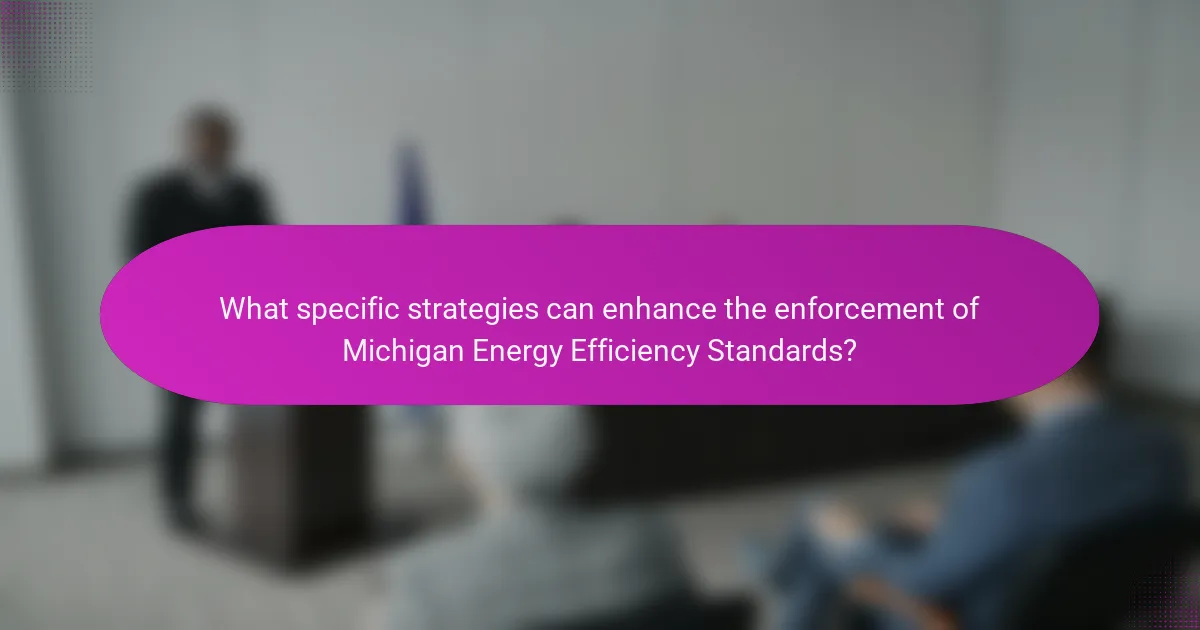
What specific strategies can enhance the enforcement of Michigan Energy Efficiency Standards?
Implementing stricter compliance audits can enhance the enforcement of Michigan Energy Efficiency Standards. Regular audits ensure that businesses adhere to energy efficiency regulations. Increasing penalties for non-compliance can also motivate adherence. This strategy has been effective in other states, leading to improved compliance rates.
Training and resources for inspectors can improve their ability to enforce standards effectively. Well-trained inspectors are more likely to identify violations. Public awareness campaigns can engage consumers in promoting energy efficiency. Informed consumers can advocate for better compliance from businesses.
Collaboration with local utilities can provide additional support for enforcement. Utilities can offer incentives for compliance, benefiting both energy efficiency and their customers. Establishing a clear reporting mechanism for violations can encourage whistleblowing. Transparency in enforcement actions can deter future violations.
These strategies, when combined, create a robust framework for enforcing Michigan’s energy efficiency standards.
How can collaboration among agencies improve enforcement effectiveness?
Collaboration among agencies can significantly enhance enforcement effectiveness by enabling resource sharing and coordinated strategies. When agencies work together, they can pool their expertise and knowledge, leading to more comprehensive enforcement actions. For instance, joint training programs can ensure that all personnel are well-versed in the latest regulations. Additionally, shared data systems allow for better tracking of compliance and violations, which can streamline investigations.
A study by the National Association of State Energy Officials highlights that states with collaborative frameworks achieve higher compliance rates. In Michigan, inter-agency partnerships could lead to more consistent application of energy efficiency standards. This collaborative approach can also foster public awareness and support, further strengthening enforcement efforts.
What are best practices for inter-agency collaboration?
Best practices for inter-agency collaboration include establishing clear communication channels. Regular meetings enhance transparency and build trust among agencies. Setting shared goals aligns efforts and resources effectively. Utilizing joint training sessions fosters a common understanding of procedures. Documenting processes and outcomes improves accountability and learning. Engaging stakeholders ensures diverse perspectives are considered. Leveraging technology facilitates data sharing and coordination. These practices lead to more effective and efficient collaboration among agencies, as evidenced by successful initiatives in various sectors.
How can shared resources optimize enforcement activities?
Shared resources can optimize enforcement activities by enhancing coordination among agencies. This collaboration allows for better information sharing and resource allocation. For instance, joint training programs can improve enforcement skills across different departments. Additionally, shared databases enable real-time access to compliance data, streamlining monitoring processes. Research shows that agencies utilizing shared resources report higher compliance rates. A study by the National Association of State Energy Officials found that coordinated enforcement strategies can reduce operational costs by up to 30%. Therefore, shared resources play a crucial role in making enforcement more efficient and effective.
What technology solutions are available to support enforcement?
Technology solutions available to support enforcement include advanced monitoring systems, data analytics tools, and automated reporting software. Advanced monitoring systems track energy usage in real-time, ensuring compliance with efficiency standards. Data analytics tools analyze energy consumption patterns to identify non-compliance. Automated reporting software simplifies the documentation process for regulatory agencies. These technologies enhance transparency and accountability in enforcement. They also facilitate timely interventions when standards are not met. Implementing these solutions can lead to improved energy efficiency outcomes.
How can data analytics improve compliance monitoring?
Data analytics can enhance compliance monitoring by providing real-time insights into operational data. It enables organizations to track adherence to regulations effectively. By analyzing large datasets, companies can identify trends and patterns related to compliance. This allows for proactive adjustments to improve adherence to standards. For example, predictive analytics can forecast potential compliance issues before they arise. Additionally, data visualization tools help stakeholders understand compliance status at a glance. According to a report by the American Council for an Energy-Efficient Economy, data-driven approaches can increase compliance rates by up to 30%. Thus, leveraging data analytics leads to more efficient and effective compliance monitoring.
What role does smart technology play in energy efficiency enforcement?
Smart technology enhances energy efficiency enforcement by providing real-time data and monitoring capabilities. It enables utilities and regulators to track energy consumption patterns accurately. This technology includes smart meters and IoT devices that collect detailed usage information. By analyzing this data, stakeholders can identify inefficiencies and ensure compliance with energy standards. For instance, smart meters can alert users to excessive energy use, promoting behavioral changes. Additionally, automated reporting systems streamline compliance verification processes. These advancements ultimately lead to improved energy conservation efforts and reduced operational costs.
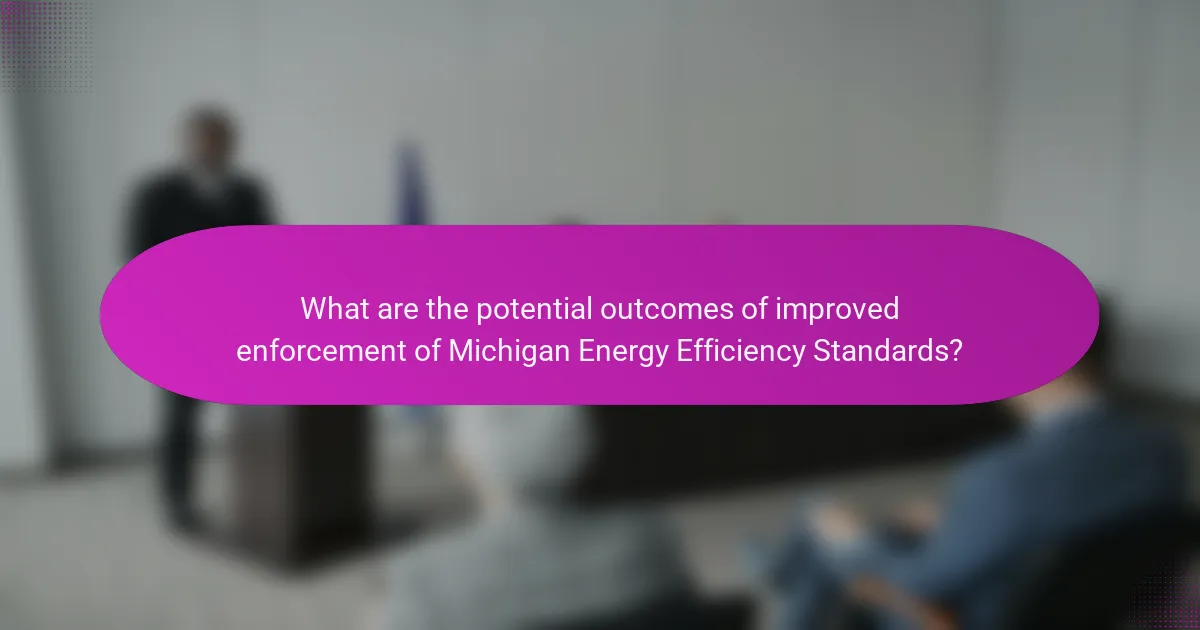
What are the potential outcomes of improved enforcement of Michigan Energy Efficiency Standards?
Improved enforcement of Michigan Energy Efficiency Standards can lead to significant energy savings. Enhanced compliance can reduce overall energy consumption in residential and commercial buildings. This reduction can translate into lower utility bills for consumers. Additionally, it can decrease greenhouse gas emissions, contributing to environmental sustainability. Improved enforcement may also stimulate job growth in the energy efficiency sector. According to the American Council for an Energy-Efficient Economy, stricter standards can lead to a more robust market for energy-efficient products. Overall, these outcomes can enhance the state’s energy security and economic resilience.
How could enhanced enforcement benefit the environment and economy?
Enhanced enforcement could significantly benefit both the environment and the economy. Stricter enforcement of energy efficiency standards reduces energy consumption. This leads to lower greenhouse gas emissions, improving air quality. Improved air quality can decrease health-related costs for communities. Additionally, energy efficiency can lower utility bills for consumers and businesses. Lower energy costs can stimulate economic growth by increasing disposable income. The U.S. Department of Energy reported that energy efficiency measures could save consumers over $500 billion by 2030. Enhanced enforcement ensures compliance, maximizing these economic and environmental benefits.
What are the expected reductions in energy consumption with better enforcement?
Better enforcement of energy efficiency standards is expected to reduce energy consumption significantly. Studies indicate potential reductions of up to 20% in energy use. For instance, enhanced compliance checks can lead to more efficient appliances being utilized. This results in lower overall energy demand. Additionally, stricter regulations can encourage innovation in energy-saving technologies. Historical data from similar initiatives shows substantial energy savings in other regions. Therefore, improved enforcement can lead to both immediate and long-term reductions in energy consumption.
How might improved standards affect job creation in Michigan?
Improved standards can positively impact job creation in Michigan. Higher energy efficiency standards often lead to increased demand for skilled labor. This demand arises from the need for retrofitting buildings and upgrading infrastructure. For instance, implementing energy-efficient technologies requires trained professionals in construction and engineering. According to a report by the Michigan Energy Innovation Business Council, energy efficiency improvements could create over 50,000 jobs in Michigan by 2025. These jobs span various sectors, including manufacturing, installation, and maintenance. Enhanced standards also stimulate innovation, fostering new businesses focused on energy solutions. As a result, a stronger emphasis on energy efficiency can drive economic growth and job opportunities in the state.
What practical steps can individuals and organizations take to support enforcement efforts?
Individuals and organizations can support enforcement efforts by actively participating in energy efficiency programs. They should educate themselves on Michigan’s energy efficiency standards and compliance requirements. Reporting violations or non-compliance to relevant authorities can help maintain accountability. Collaborating with local governments on energy audits can enhance compliance monitoring. Organizations can also provide training for staff on best practices in energy efficiency. Financially supporting initiatives aimed at improving energy efficiency can drive community engagement. Additionally, advocating for stronger enforcement policies can lead to more effective regulations. Engaging in public awareness campaigns can inform others about the importance of these standards.
How can residents contribute to energy efficiency initiatives in their communities?
Residents can contribute to energy efficiency initiatives in their communities by participating in local programs and adopting sustainable practices. They can engage in community workshops that promote energy-saving techniques. Residents can also implement energy-efficient appliances in their homes. Additionally, they can advocate for local policies that support renewable energy sources. Joining local environmental groups can amplify their efforts. They can also share knowledge about energy efficiency with neighbors. According to the U.S. Department of Energy, community involvement can significantly enhance the impact of energy efficiency initiatives.
What resources are available for businesses to comply with energy efficiency standards?
Businesses can access various resources to comply with energy efficiency standards. These resources include government programs that offer financial incentives. For instance, the Michigan Energy Office provides grants and rebates for energy-efficient upgrades. Utility companies also offer programs to support energy efficiency improvements. Additionally, businesses can utilize technical assistance from organizations like the U.S. Department of Energy. Online tools and calculators are available to help assess energy usage and savings potential. Training programs are offered to educate staff on best practices in energy management. Furthermore, industry associations provide guidelines and resources tailored to specific sectors. These resources collectively assist businesses in meeting compliance requirements effectively.
The main entity of this article is Michigan Energy Efficiency Standards. The article outlines the key challenges in enforcing these standards, including limited funding, lack of public awareness, and regulatory complexities. It discusses the impact of regulatory frameworks on enforcement, the role of stakeholders in compliance, and the barriers hindering effective enforcement. Additionally, it examines how public engagement and technological solutions can enhance compliance monitoring, and highlights the potential outcomes of improved enforcement, such as energy savings and job creation in Michigan.
